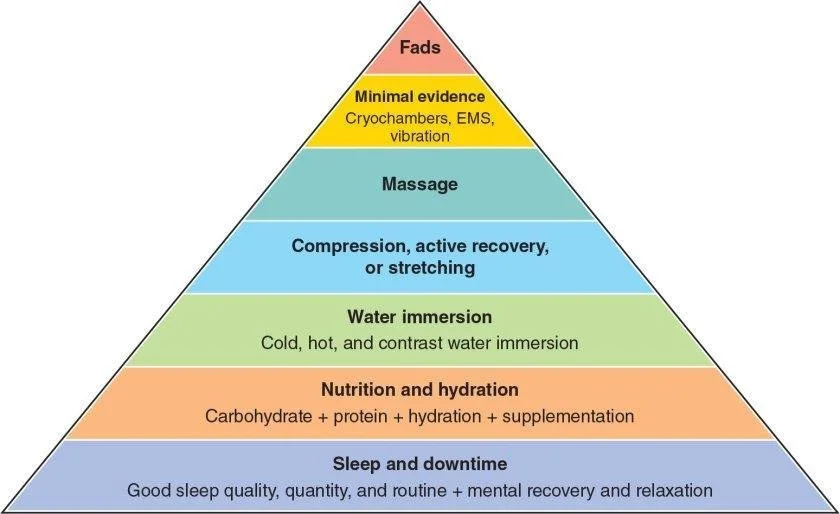Recovery Post-Exercise
When discussing physical recovery in between exercise sessions an excellent reference point is the recovery principles by NSCA's (National Strength and Conditioning Association) Essentials of Sport Science pyramid.
Sleep and Downtime:
It is well documented how important sleep is for health and how it can be variable depending on many factors such as anxiety, stress, medication, alcohol, caffeine, and changes in routine. Sleep deprivation can lead to reduced physical performance, reduced mental performance, reduced motivation, difficulties concentrating, suboptimal levels of energy, and higher levels of perceived pain or exertion.
Sleep and downtime are both needed to allow the body to restore any depleted nutrients and prepare for the next movement cycle. It is also a time for tissue to repair and build, supporting adaptations following exercise.
Having a bad night of sleep on occasion is normal, if you do, don’t panic! Do, however, try and focus on good sleep hygiene to ensure you are improving what you can control around your sleep.
Nutrition and Hydration:
What you eat and drink following a bout of exercise can play a big role in your recovery. Post-exercise nutrition is a heavily researched topic, especially when it comes to optimising recovery following sporting performance in athletes. Here are some general recommendations for your post-exercise meal:
Following cardiovascular-based exercise:
Include a portion of good quality carbohydrate to replenish glycogen (energy) stores. Some options may include: oats, wholewheat pasta, wholemeal bread, brown rice, grains and pulses.
Include some good quality protein to support muscle recovery and repair such as: fish, eggs, lean meats, tofu, beans, lentils.
Rehydrate! Fluid will have been lost through sweat while exercising. Water is your best option here.
Following resistance exercise:
Aim to consume 15-25g of good quality protein to support muscle development, recovery and repair.
15-25g protein equates to ~1 chicken breast, ~1 salmon fillet, 2-3 large eggs, 150g of tofu
Rehydration is still important!
As always, we need to remember that nutrition is very personal. Each of us will have specific food preferences and dietary requirements, so do your best to incorporate the above recommendations into those diets.
Active Recovery and Stretching:
During the initial recovery from exercise, the aim is to bring the body back to a homeostatic state (i.e. re-establish the initial state before the exercise). Following this return to normal our body can focus on any adaptations or super-compensation to meet the demands of the training.
Both stretching and active recovery can aid recovery between exercise sessions.
Why active recovery?
Active recovery consists of moving the body in between exercise sessions and at a lower intensity than the training level. Active recovery clears more accumulated blood lactate than rest alone, especially when done after strenuous activity. It improves blood flow to the muscles, maintains flexibility and helps with adherence to wider activity goals (for example, increasing your step count!)
Why stretching?
Stretching in between training sessions can be static or dynamic. Static-stretching is extending a muscle as close to its full length as possible and then holding for 15-30 seconds. Dynamic- stretching is extending the muscle to its full length, holding for only 1-3 seconds and then reducing the stretch and repeating a couple of times. Main objectives of stretching: enhance range of motion, reduce muscle stiffness or soreness and to keep the body moving in between sessions.
Health Fads:
Health fads can refer to dietary or physical information that surfaces which may lack scientific evidence, trials or sufficient time frames to see whether they are actually sound in their claims. These range from extreme exercise regimes to restrictive diets which could be dangerous or have no potential benefit. We are often bombarded with these on social media platforms. When looking at recovery from exercise we are talking about options such as cryo-chambers, vibration or EMS machines which claim to assist with enhanced or speedier recovery following exercise. At the moment many of these lack sufficient evidence to prove whether they do or do not work.
A Summary of What You Can Do:
Aim for regular good quality sleep with downtime to rest.
Nourish and hydrate your body.
Stretch regularly and keep your body moving in between training sessions.

